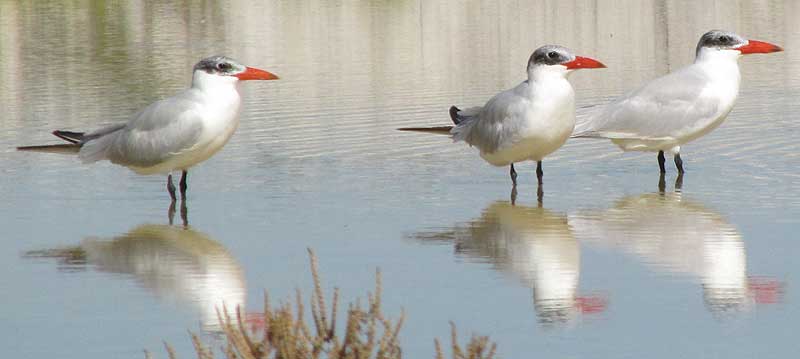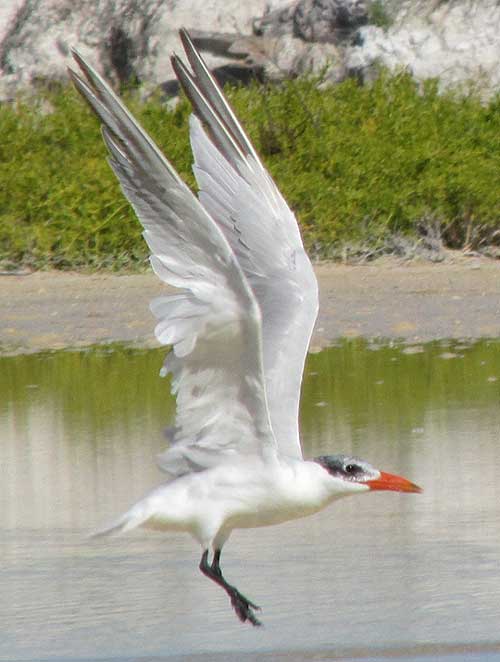Excerpts from Jim Conrad's
Naturalist Newsletter

from the November 16, 2014 Newsletter issued from Río Lagartos, on the Yucatan Peninsula's northern coast (~N21.60°, ~W88.16°), Yucatán state, MÉXICO
CASPIAN TERNS
Nowadays it's easy to find Caspian Terns, HYDROPROGNE CASPIA, in Ría Lagartos. Above, you can see some in their winter, or basic, plumage, and admire their distinctively massive, red beaks. A bird closer up, with wings lifted in flight, is shown below:

With a wingspread of 53 inches (1.35m), this is our largest tern and can only be confused with the Royal Tern, whose orange beak can at times look a little reddish, and is nearly as big. However, the Royal Tern's tail is more deeply forked than the Caspian's, plus notice that the tip of our Caspian's reddish beak darkens. The Royal Tern's beak doesn't display such a bruised-looking tip.
Caspian Terns turn up in waters worldwide, except in South America. In the Yucatan they're nonbreeding winter visitors.
What's the difference between a tern and a gull? With a little practice, you can distinguish them by the terns' longer, narrower wings and more buoyant flight. Most terns have forked tails while most gull species have rounded ones. Also, terns have sharp-pointed bills while gulls have hooked ones.
from the March 15, 2015 Newsletter issued from Río Lagartos, on the Yucatan Peninsula's northern coast (~N21.60°, ~W88.16°), Yucatán state, MÉXICO
THREE TERNS ON A MUDFLAT
During a flamingo-viewing trip we passed a mudflat loaded with Black Skimmers, Laughing Gulls, White Pelicans and terns. It was the terns who caused us to turn the boat back, park and study awhile, because something didn't seem right here. You can see the situation below:

The little tern in the middle is a Forster's Tern, very common here at this time of year. Of the tern species found in our area, the two largest are the Royal and Caspian Terns, and the two terns flanking the Forster's are definitely of the larger kind. We always say that the Royal Tern's beak is orangish, while the Caspian's beak is red. The confusing thing is that the two big terns in the picture clearly are different from one another, yet they both have orangish beaks. Caspian Terns are bigger than Royal Terns, with more massive beaks and their winter plumage includes darker foreheads, so we thought that the bird at the right should be a Caspian with a red beak, not orangish.
Finally we found in Howell's A Guide to The Birds of Mexico and Northern Central America a description of the juvenile Caspian Tern's beak, saying that it's "reddish orange to orangish with dark tip." Well, our bird's beak if anything is pale tipped, but at least now we know that immature Caspian Terns can have orangish beaks.
Immature birds and adults in winter plumage, which is the case with most birds in the estuary at this time of year, can be real challenges.